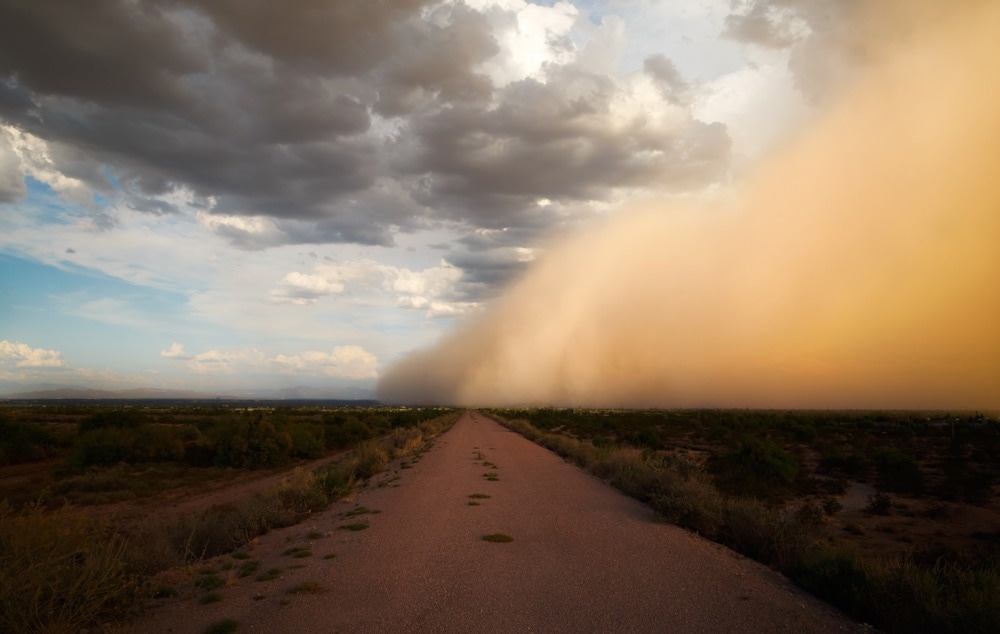A team of scientists led by Professor Longlong Wang at the School of Remote Sensing and Information Engineering, Wuhan University, studied the changing properties of Asian dust storms over the Jianghan Plain in central China. The findings, published in Remote Sensing, analyze data continuously collected over 15 years from 2006 to 2021. Cloud-Aerosol Lidar with Orthogonal Polarization (CALIOP), which accumulates space-borne observations and Modern-Era Retrospective Analysis for Research and Applications version 2 (MERRA-2) were used in this study.

Study: Climatology of Dust Aerosols over the Jianghan Plain Revealed with Space-Borne Instruments and MERRA-2 Reanalysis Data during 2006–2021. Pritha_EasyArts/Shutterstock.com
Dust is essential to the climate system's functioning and is one of the primary forms of aerosols in the atmosphere. The seasonal characteristics of dust storms are evolving due to climate change and human involvement.
Effect of Dust on the Earth's Atmosphere
Dust, a significant component of aerosols in the atmosphere, has an enormous impact on the earth's environmental changes. These effects can be categorized as follows:
- Direct effect - Dust in the earth’s atmosphere directly absorbs solar radiation. Absorbed energy is also scattered through airborne dust in all directions, ultimately impacting the storage and distribution of heat.
- Semi-direct effect - The quality associated with absorbing solar radiation by dust particles inadvertently heats and disperses clouds. Drying up the atmosphere of water also adversely affects the radiation budget.
- Indirect effect - While semi-directly dust particles can disperse clouds, they are also responsible for forming them by assisting as ice nucleating particles and cloud condensation nuclei.
Dust Aerosol Formation and Transport
Observation and analysis of dust aerosol formation and subsequent transport have been recorded over time. A dust belt connecting the west coasts of North Africa, through the Arabian Peninsula, to Asia has been observed in the Northern hemisphere. The Taklimakan and Gobi deserts are significant sources of dust emissions worldwide. They contribute to around 40% of all dust production in the atmosphere. The transport of dust emitted in the Taklimakan and Gobi deserts to central China directly impacts climatology in that region. Seasonal weather patterns have been linked to the migratory impact of aerosol dust.
Professor Wang and his colleagues studied these climate effects by focusing on the Jianghan Plain in central China. Their objective was to draw behavioral patterns on climatology due to aerosol dust by analyzing dust occurrence frequency, altitude distribution, dust column mass concentration and trajectory clusters.
Jianghan Plain
The Jianghan Plain’s geographic location makes it an important focus to study the impact of aerosol dust movement. At 46,000 square kilometers in size, the Jianghan Plain is influenced by dust sources traveling through it emanating from Taklimakan and Gobi deserts but also acts as a conduit in spreading the particles to regions beyond.
Methodology and Data Collection
Data collected from 2006 to 2021 was analyzed in the study. The primary drivers were the Cloud-Aerosol Lidar and Infrared Pathfinder Satellite Observation (CALIPSO) and Modern-Era Retrospective Analysis for Research and Applications version 2 (MERRA-2), which provided large amounts of data.
CALIPSO, launched in 2006, carries the Cloud-Aerosol Lidar with Orthogonal Polarization (CALIOP) instrument onboard. CALIOP is used to detect the vertical structure of the atmosphere by analyzing the total and polarized backscattered light.
MERRA-2 is a powerful tool used to assimilate massive atmospheric datasets. NASA's Goddard Earth Observing System Model, Version 5 (GEOS-5), combines a 3D variational data assimilation (3D-Var) algorithm to produce MERRA-2. The Jianghan Plain's long-term fluctuation was examined in this study using the MERRA-2 monthly dust column mass concentration at specific resolutions. Additionally, in a case study, the distributions of the dust column mass concentration and dust mass flux per 12 hours were obtained using MERRA-2
Results
The statistical findings show that dust particles often enter the Jianghan Plain in the spring and winter.
Altitudes can reach up to 4-6 km, with occurrence frequencies surpassing 0.70. The occurrence frequency decreased to roughly 0.40 during the autumn season. In the summer months, the frequency could even go down to zero. During the low-frequency occurrence periods, the dust plumes hover around 1-3 km altitudes.
Spring time produced the highest dust mass concentrations and dust extinction coefficients in the Jianghan Plain. The source of which was traced to both the Taklimakan and Gobi deserts. The Taklimakan Desert was the exclusive source of dust plumes during winter and autumn.
The particle depolarization ratios measured 0.1-0.2 at altitudes below 4 km. This was independent of the seasons in which the data was measured, indicating a potential blending with nearby anthropogenic aerosols.
The Jianghan Plain's mean springtime dust column mass concentrations were seen to drop between 2006 and 2015 due to the decline in dust activity in the Asian dust's source regions.
Outlook
This study's critical focus areas are frequency, vertical distribution, optical characteristics, and dust column mass. To fully comprehend the features of dust particles encroaching on the Jianghan Plain area and their related effects on the local environment, cloud process, and climate system. Further analysis connecting the seasonal fluctuations in dust occurrence frequency, optical characteristics, and concentration will provide deeper insights into dust aerosol contributions to climate change.
References
Liu, Chuan, Zhenping Yin, Yun He, and Longlong Wang. (2022) Climatology of Dust Aerosols over the Jianghan Plain Revealed with Space-Borne Instruments and MERRA-2 Reanalysis Data during 2006–2021. Remote Sensing 14, no. 17: 4414. https://www.mdpi.com/2072-4292/14/17/4414/htm
Disclaimer: The views expressed here are those of the author expressed in their private capacity and do not necessarily represent the views of AZoM.com Limited T/A AZoNetwork the owner and operator of this website. This disclaimer forms part of the Terms and conditions of use of this website.